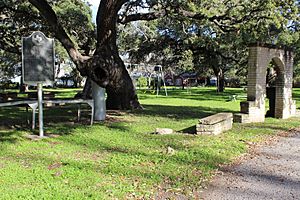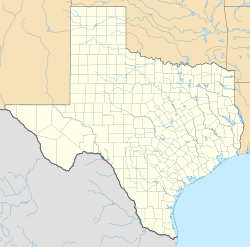Staples, Texas facts for kids
Quick facts for kids
Staples, Texas
|
|
|---|---|
 |
|
| Country | United States |
| State | Texas |
| County | Guadalupe |
| Incorporated | 2008 |
| Area | |
| • Total | 1.50 sq mi (3.89 km2) |
| • Land | 1.50 sq mi (3.88 km2) |
| • Water | 0.00 sq mi (0.01 km2) |
| Elevation | 525 ft (160 m) |
| Population
(2020)
|
|
| • Total | 193 |
| • Density | 128.7/sq mi (49.61/km2) |
| ZIP code |
78670
|
| Area code(s) | 210, 726 (planned) |
| FIPS code | 48-70052 |
| GNIS feature ID | 2633299 |
Staples is a small city located in the northeastern part of Guadalupe County, Texas, United States. In 2008, the people living in Staples voted to officially become a city. This process is called incorporation. Out of 125 votes, 87 people (about 70%) voted yes, and 38 people (about 30%) voted no.
After becoming a city, Staples held its first local election on November 4, 2008. Eddie Daffern, who helped organize the effort to make Staples a city, was elected Mayor without anyone running against him. Five people were also elected to be Aldermen, which are like city council members. These included Carol Wester, Ronnie Clark, Bert "Bubba" Reinke, William A. York, and Shaun Seale.
According to the 2020 census, Staples had 193 residents. The city also has a barber shop, two beauty shops, and a cafe. Staples is part of the larger San Antonio metropolitan area.
Geography of Staples
Staples is found in the northeastern part of Guadalupe County. It is just west of the San Marcos River, which creates the border with Caldwell County.
The city is located:
- About 11 miles southeast of San Marcos.
- About 21 miles northeast of Seguin, which is the main city of Guadalupe County.
- About 16 miles northwest of Luling.
- About 16 miles southwest of Lockhart.
Texas State Highway 130 goes through the southern part of Staples. This highway offers a new route between Austin, which is about 41 miles north, and San Antonio, about 56 miles southwest.
The U.S. Census Bureau states that the city of Staples covers a total area of about 3.9 square kilometers (1.5 square miles). A very small part of this area, about 0.01 square kilometers (0.003 square miles), is water.
Population Changes in Staples
Demographics is the study of how populations change over time. This section shows how the number of people living in Staples has changed throughout history.
| Historical population | |||
|---|---|---|---|
| Census | Pop. | %± | |
| 1870 | 30 | — | |
| 1880 | 45 | 50.0% | |
| 1890 | 125 | 177.8% | |
| 1900 | 150 | 20.0% | |
| 1920 | 120 | — | |
| 1930 | 100 | −16.7% | |
| 1940 | 250 | 150.0% | |
| 1950 | 150 | −40.0% | |
| 1960 | 140 | −6.7% | |
| 1970 | 70 | −50.0% | |
| 1980 | 65 | −7.1% | |
| 1990 | 75 | 15.4% | |
| 2000 | 350 | 366.7% | |
| 2010 | 267 | −23.7% | |
| 2020 | 193 | −27.7% | |
| U.S. Decennial Census | |||
As you can see from the chart, the population of Staples has gone up and down over the years. For example, it grew quite a bit between 1990 and 2000, but then decreased by 2020. These numbers come from the U.S. Decennial Census, which counts the population every ten years.
Education
Students who live in Staples attend schools that are part of the San Marcos Consolidated Independent School District.
See also
 In Spanish: Staples (Texas) para niños
In Spanish: Staples (Texas) para niños



